#queensland snake-lizard
Text
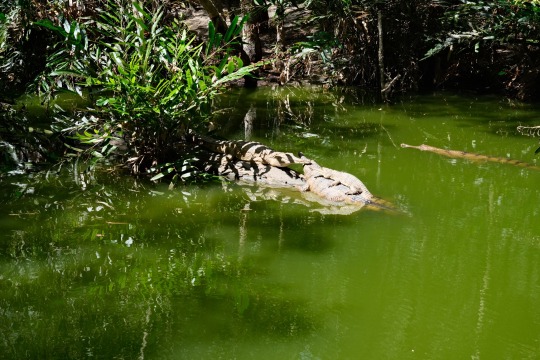







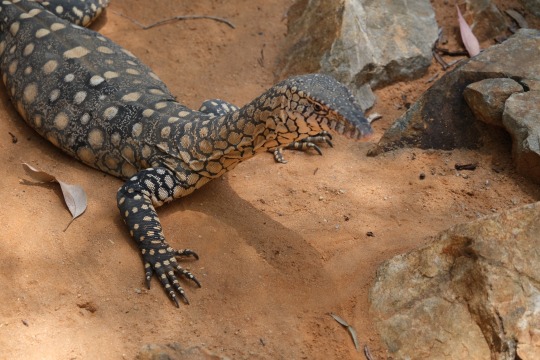
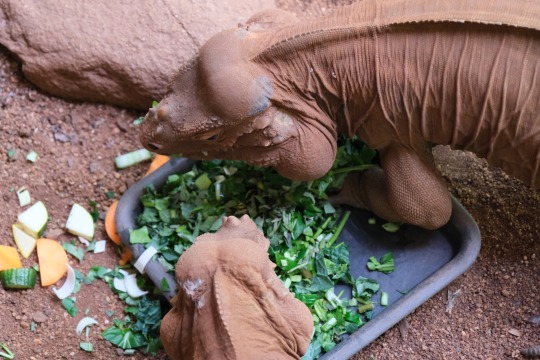
1 note
·
View note
Text

Surprise discovery of snake-like lizard feared extinct leaves scientists amazed
Researchers found three species of skink in Australia they feared could be extinct, including the Lyon's grassland striped skink.
Researchers in Australia have rediscovered a secretive lizard with tiny legs that they thought may be extinct after it evaded detection for more than 40 years.
A team from the Queensland Museum and James Cook University spotted Lyon's grassland striped skinks (Austroablepharus barrylyoni) — which haven't been seen since 1981 — at several sites near Mount Surprise in northeastern Australia, according to a statement.
The researchers also saw two other threatened lizards: Mount Surprise sliders (Lerista storri) and limbless fine-lined sliders (Lerista ameles). All three species are members of the skink family, known for their snake-like features and tiny, sometimes non-existent, limbs...
Read more: https://www.livescience.com/animals/lizards/surprise-discovery-of-snake-like-lizard-feared-extinct-leaves-scientists-amazed
78 notes
·
View notes
Text
Facts about
✨Komodo dragons✨
It may surprise you, but Komodo dragons aren’t dragons. (Big surprise)
They’re only the biggest lizard that can grow up to 3 meters long (10ft), can weigh up to 70 kg, can run up to 20 kilometres per hour and can live up to 30 years. It takes them 8 to 9 years to fully mature, which is quite long for animals if you ask me.
They’re also highly venomous. They used to think that this was because of various bacteria in it’s mouth, but that theory was proven wrong by the University of Queensland. The people now say that their venom is similar to that of a snake.
They only/mostly eat meat. They kill their prey by biting down hard and shaking violently, ripping off flesh and muscles causing extreme blood loss and shock. They also have an excellent smell which comes in handy when hunting. They use their tongue to smell. They can smell a rotting prey from 4 kilometres (2.5 miles) away! Though their eyesight and hearing are less impressive.
They’re tail is (almost) as long as their body. They can also use their tail as weapon. (It’s strong enough to take down a deer!)
Komodo dragons use their tail to scare prey by swinging it around. They also use it she they are scared themself.
Fun fact, they can also swim! They have been spotted as far as miles off the shore! Why do I say shore? Because they only live on 5 Indonesian islands. One of these islands has been given the name ‘Komodo island’.
Some people are also saying that Komodo’s might originate from Australia. This is because they have found fossils of big lizards from 300.000 to 4 million years ago!
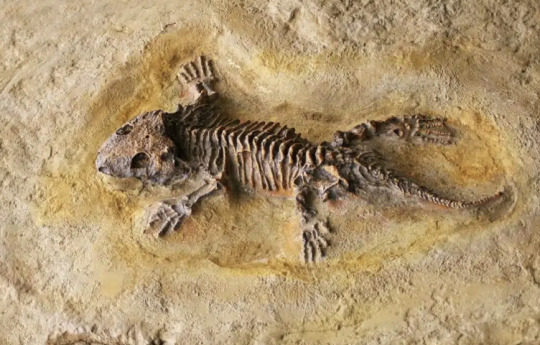
A fun facts is that Komodo dragons can produce asexually! The female Komodo dragons have both male and female sex chromosomes. If you want to research more about this, you can search up ‘parthenogenesis’ because that is what it was called.
Also, look at the little baby

Cute right?
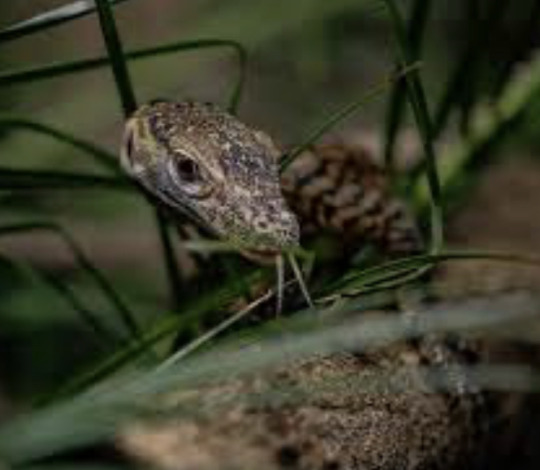
Yea.
Another fun fact, (yes, there is more) they have shark like teeth! They have 60 teeth in total, tge most of all lizards and reptiles. Now, if you look at their mouth, you’ll probably not see them. This is because their gums are so thick. Don’t be fooled though! They definitely are there. Just think of it like toothless from httyd.
They are also very playful! They have been observed to play with shoes, shovels and frisbees. They also like to play tug of war.
And this was all! Have a nice day :D
28 notes
·
View notes
Note
Love your blog! Have you ever dealt with a Banded Pygmy Python (antaresia spp) from Australia? I’m keen to get a snake one day and I think these lil guys are pretty funky. Do you know if Pygmy pythons have any special requirements compared to “full size” pythons?
I'm afraid I haven't! Banded pygmy pythons are a varient of Stimson's pythons (Antaresia stimsoni) which are smaller and have a distinctive banded pattern. They are also impossible to find outside of Australia, which is why I haven't ever met one! They're found only in extreme northern Queensland and they're so cute! They're considerably smaller than regular Stimson's pythons (about 60 cm at the absolute longest), and their care isn't really different from your standard Stimson's.
Because of their smaller size, be 100% sure you buy a snake that's eating well on f/t rodents! Their small size means it'll be tempting for breeders to get them started on lizards, and it's hard for a beginner to get them on rodents after that.

70 notes
·
View notes
Text
STEVE IRWIN
STEVE IRWIN
1962-2006
Steve Irwin was born on his mother’s 20th birthday in Melbourne, Australia; not long after his parents moved to Queensland to run a wildlife park in Queensland. Irwin grew up around crocodiles, snakes, lizards, koalas and other animals. He was given a pet python on his 6th birthday, when he was 9 he was out catching crocodiles with his dad. They would have to catch crocodiles that wandered too close to towns and homes and would bring them back to the wilderness or to the park.
Irwin got married to an American conservationist Teri Raines in 1992 and they spent their honeymoon in the wilderness. They had two children, Bindi and Robert, who also grew up with the love of animals and conservation. The Irwins started filming their adventures on video which led to making a television series, The Crocodile Hunter (1996) where Irwin became known for his catchphrase ‘Crickey!’.
Every year, Irwin put $1 million into charity that purchased land around Australia for preservation. In 2003, Irwin was filming a documentary in Mexico when he and the crew heard on the radio that two scuba divers went missing in the area. The group suspended filming to search and discovered one of the divers clinging onto a rock ledge on the side of a cliff and he was helped into Irwin’s boat. The other diver, was found dead later that same day.
Irwin died aged 44, on 4 September 2006 when a stingray barb pierced his chest and penetrated his heart which resulted in him bleeding to death. The incident took whilst shooting a documentary on the Great Barrier Reef.
Irwin’s memorial took place on 20 September 2006; at the Australia Zoo ‘Crocoseum’. His daughter Bindi, aged 8, read a eulogy to her father, ‘I have the best daddy in the world and I will miss him every day. Most of all, he was fun. My daddy is my hero.’
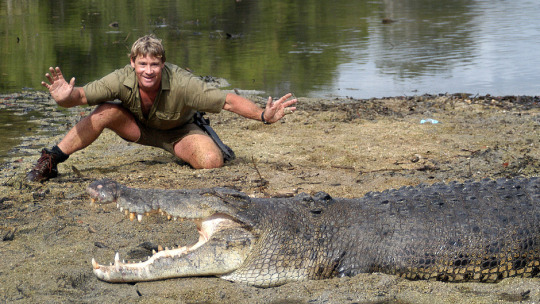
#steveirwin #thecrocodilehunter #australiazoo
6 notes
·
View notes
Text
The Min Min Lights
The story of the Min Min lights comes from Indigenous Australian culture, first recorded near the now-abandoned Queensland town of Min Min.
A Min Min light is described to be a medium circular ball of fuzzy light, like a swarming ball of buzzing bees, usually white but sometimes reported to be green, yellow, red, and even blue.
These mysterious balls of light like to move and almost dance around somewhat erratically, up, down, left, right, backwards, forwards, even at odd angles. They have even been reported to split into two, equally as big, identical lights!
They are known to bob around erratically, and when you approach them they begin to retreat before eventually disappearing into the outback.
Now this is actually a personal encounter my grandfather had on his property with, what he believed to be, a Min Min light.
My grandfather lived on a massive property in a small outback town in western Australia, and it was surrounded by two massive 7ft fences, so there was an exterior fence and an interior, which was to protect the livestock from things like dingoes, foxes, snakes, lizards and wild dogs. And for extra protection, late every evening my grandfather and one his workmen would walk along these fences and place traps for rabbits and any other animal they may catch by the fence.
So they would collect their traps and grab a little oil lantern each, and the workman would walk the inner fence and my grandfather would walk the exterior fence, gradually placing traps along the way.
They would stop, put down the lantern, set the trap, pick up the lantern and keep walking, repeating the process every couple of metres. They would always keep in line, side by side a few metres apart, through the fence, but it was always so dark they could only keep track of each other's position by the small dingy little oil lantern they carried.
So this one evening they are doing their usual routine, stopping, putting down the trap and then picking up and moving on. They do this over and over again, occasionally looking over to make sure they are keeping up, but they had done it so many times now that they hardly had to check in to keep pace anymore. So my grandfather had placed a few traps on his own and looked up to confirm the workman’s lantern position only to find his lantern was 5 or so metres ahead.
The workman must have gone on without him.
My grandfather grabs his things and tries to hurry to catch up, he looks down to watch his steps so he doesn’t trip over a branch or rabbit hole, and when he looks back up he sees the workman’s lantern has moved another 5 metres or so away.
My grandfather is utterly confused but quickly stops to set the trap before wordlessly continuing to try and keep up with his workman.
However this time, he watches as the glowing orb of the lantern suddenly leaps into the air before landing on the ground, 5 metres away. My grandfather stopped in absolute shock.
Had the workman just thrown his lantern?
But if he did, why didn’t it smash and set the whole area on fire?
Once again the light leaps into the air, landing another 5 metres away.
Now my grandfather was sure that the workman wasn’t able to lay his traps in that time so he tries to walk over and approach the fence and the workman, but before he can reach the fence, the orb suddenly leaps completely over the 7ft fence to his side, again, 5 metres in front of him.
This makes my grandfather freeze in place. What was going on?
All of a sudden the voice of the workman calls my grandfather, “Oi why are you going so far ahead? I can’t keep up!” His voice called from behind my grandfather.
My grandfather quickly spun around to see the workman was indeed about 15 metres behind him, with his lantern in his hand.
In that moment he realised the light he was following was not the workman’s lantern, and when he looked back it was completely gone.
It wasn’t until years later when he learned the story of the Min Min lights from local elders, who believed these were the spirits of mischievous aboriginal entities appearing to trick the white people into getting lost in the outback, did he realise what he encountered. Although some also believe they may appear to guide people lost in the outback, home again.
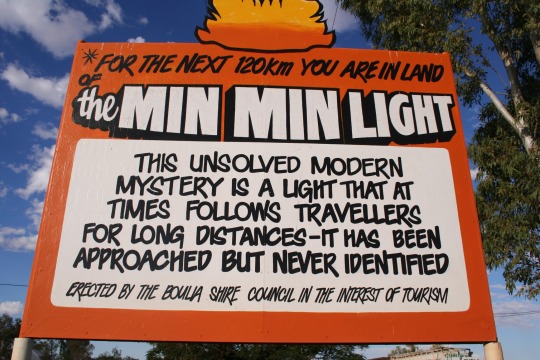

#creatures#cryptid#eerie#creepy#australia#indigenous australians#aboriginal culture#scary#true story#mythical creatures#magic#interesting#trending
4 notes
·
View notes
Text
Steve Irwin, the crocodile hunter!
Steve Robert Irwin was born in Upper Ferntree Gully, Victoria on February 22nd, 1962. His family moved to Beerwah, Queensland. They opened the ‘Beerwah Reptile Park’ in 1970.
Steve loved wildlife, especially reptiles. At the tender age of six, he caught his first venomous snake – a common brown. It is said that Steve would often arrive late to the school, he often managed to convince his mother to pull over, so that he could rescue even a lizard off the road!
Steve was pretty adventurous from a very young age. When he was just 9-years-old, he used to help catch small problem crocodiles, hanging around boat ramps. He used to jump on them in the water, wrestle them back into the dinghy. When it came to wildlife, Steve always had an uncanny sixth sense!He spent his entire life honing the very same skill!
The wildlife park was renamed as the ‘Queensland Reptile and Fauna Park’ by the 1980s. It was Steve’s home, the place he loved the most! He spent hours at the place, working continuously along with his best mate West Mannison. Together, they took care of the wildlife and maintained the grounds!
Steve’s love for crocodiles kept growing. He used to spend months in the most remote areas of far north Queensland, helping the government catch problem crocodiles. His dog Sui used to accompany the crocodile hunter in all his missions. The crocodile capture and management techniques developed by Steve are utilized with crocodilians around the world!
From October 4, 1991, Steve started managing the park. Soon he came across Terri Raines – a visiting tourist. The couple got married in Eugene, Oregon on June 4, 1992.
Instead of going for a honeymoon, the couple took up the task of filming a wildlife documentary while relocating a problem crocodile in far north Queensland. The show was an instant hit, giving birth to the series called ‘The Crocodile Hunter!’ The TV series soon became an internationally broadcast wildlife documentary that was hosted by Steve and his wife Terry. They worked tirelessly for improving and expanding the wildlife park. It was renamed as ‘Australia Zoo’ in 1998, gradually their vision for the best zoo in the world was coming into fruition. Even today, the zoo strives hard to achieve Steve’s message of ‘conservation through exciting education!’
Read more : https://blog.stuidapp.com/steve-irwin-the-crocodile-hunter/
1 note
·
View note
Text
Some lizards have evolved to resist deadly snake venom • Earth.com
New Post has been published on https://petn.ws/AECiR
Some lizards have evolved to resist deadly snake venom • Earth.com
A new study led by Professor Bryan Fry at the University of Queensland offers interesting insights into how lizards have adapted to survive snake venom attacks. Lizards and snakes have been locked in a remarkable evolutionary battle for millennia. Venomous snakes wield a powerful weapon, but their reptilian cousins have developed fascinating ways to stay […]
See full article at https://petn.ws/AECiR
#ExoticPetNews
0 notes
Text
In reply, the Kalgoorlie Sun ran a spoof interview of George Washington conducted apparently by the great hoaxer of the time, Louis de Rougemont. The subject was the pastoral prospects of Mr Washington's Laverton acres:
"Of course there is no grass whatever there, but salmon gums, granite rocks, ant beds, spinifex and mirages are to be found in abundance, on which bungurras, lizards, carpet snakes, and other stocks are said to thrive splendidly." I believe there is a plant called parrakelia that grows there which contains a great amount of moisture? "Oh yes," was the reply: "in one small patch I extracted water with my little hatchet sufficient to supply a private distillery for five years, and in addition to that, I captured 245½lb. of Murray cod." "But with regard to the cattle, how does the country suit them?" asked the scribe. "Splendidly," replied George. "I hold a stretch of country under a pastoral lease 316 miles long by 276 miles wide; three weeks ago I placed 959 bullocks on it, and they have done so well that the mirage fodder has led them away." "Have you seen horses reared there Mr. Washington?" "Oh yes; I have seen horses bred there which, in proportion to their frames had the largest curbs and splits I have seen on any horses in Australia. My father was engaged in cab-driving all his life in Queensland, and as I have been connected with cab horses as long as I can remember, I should be a judge of curbs." In reply to a question as to the water supply for grazing purposes, Mr. Washington said that there was ample water to be obtained by sinking; an unfailing supply of beautiful salt water may be had at depths varying from 95ft. to 360ft. The advantage of fattening cattle on salt water must be apparent to every butcher as it saves 75 per cent. of salt in curing the beef. After thanking Mr. Washington for his information I withdrew, just as he commenced to speak of wild oats which he had found at an old roadside camp, where carriers had been feeding horses.—Yours, etc.
Louis de Rougemont
"Killing for Country: A Family History" - David Marr
#book quotes#killing for country#david marr#nonfiction#kalgoorlie#wa#western australia#australia#the sun#newspaper#journalism#spoof#george washington#louis de rougemont#pastoral#laverton#satire#salmon gum#eucalypts#granite#ants#spinifex#mirage#bungurra#lizards#carpet python#parrakelia#water#cattle#horses
1 note
·
View note
Note
I won’t lie to you, there has been a lot of wildlife around our house here recently 😒 Even I’ve been like what the hell! With heat and rain, we’ve had - frogs, toads, geckos, bats, kookaburras (my fave 😍), lizards, massive huntsman spiders OMG they’re huge lately 😩 And snakes.. Non venomous thank goodness but they still freak me out! Had a little green tree snake which was ok but also a massive carpet python which are like the pet cat of snakes but still freaky and pretty sure it’s in our roof 🥴 So yeah. But if you live or stay near city you’re good! We are semi-rural. I grew up in Melbourne city and had zero wildlife in the suburbs. Queensland is a different game.
oh my goodness 😂 anything but snakes and spiders! i HATE both of those things. the others are cute. bats freak me out a bit, in general i feel that way about animals that fly because of the flapping wings, but they’re actually adorable in their own way.
koalas are one of my top favorite animals, i would like to see one 🐨
0 notes
Photo

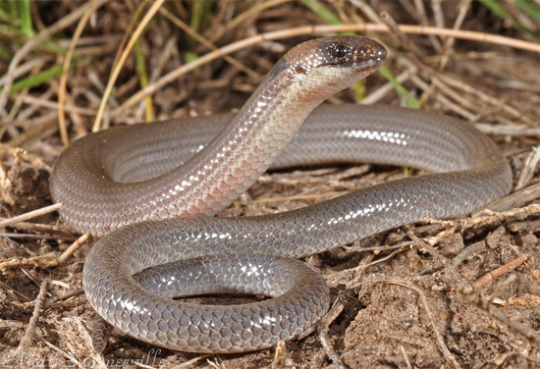
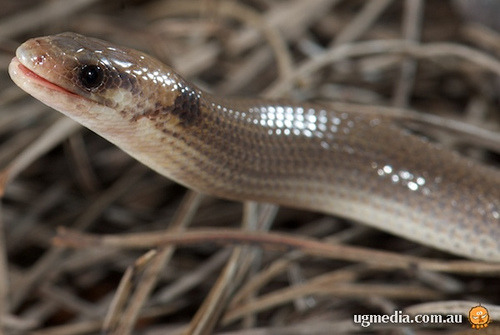
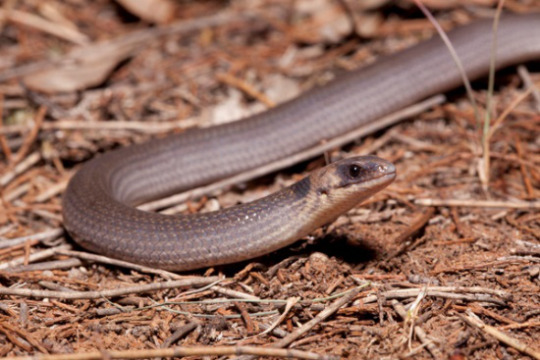
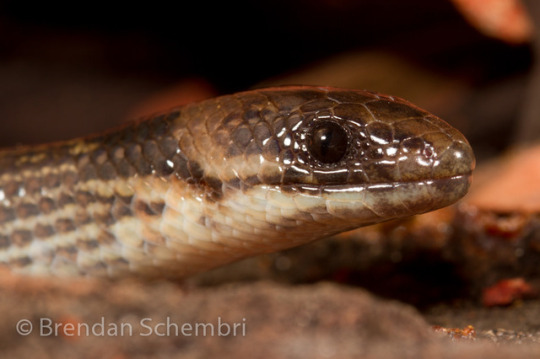
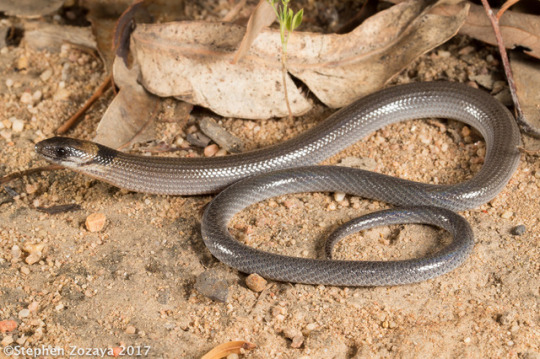


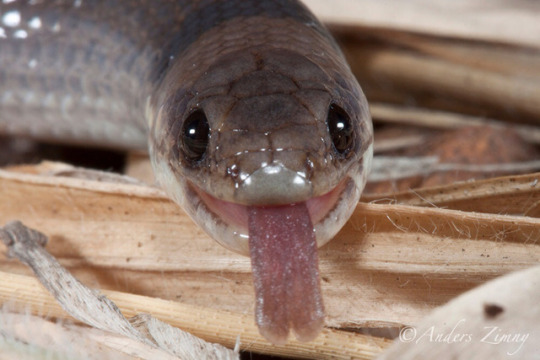
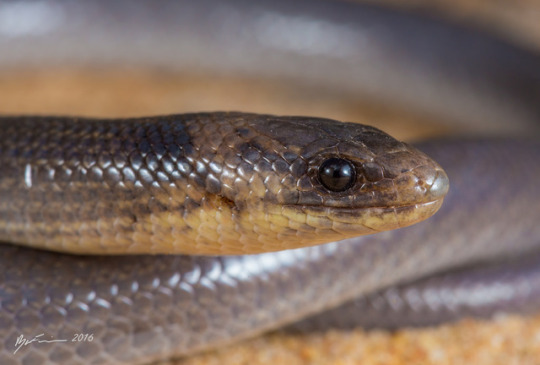
Queensland Snake Lizard
The Brigalow scaly-foot or Queensland snake-lizard (Paradelma orientalis) is a species of lizard endemic to Australia. This species is a flap-footed or ‘legless’ lizard, so called because it has completely lost its forelimbs but has a small scaly flap that is remnant of its hindlimbs. This slow moving nocturnal species is mostly terrestrial (lives on the land), although it has been recorded climbing the rough bark of wattles. When alarmed, the species will rear its head and fore body and flicks its tongue, possibly to mimic venomous snakes.
The Brigalow scaly-foot is a legless lizard that grows to approximately 6.3 inches. It is a heavy set lizard with a round snout, prominent ear openings, fairly large limb-flaps and a tail twice the length of the body. The body is grey to greyish brown in color and the base of the head is cream to pale brown. A distinctive black bar crosses the back side of the neck.
This species is endemic to Queensland and occurs mostly in the Queensland Brigalow Belt (QBB) bioregion, from Inglewood on the southern downs, north to Emerald and east to Gladstone. However, its distribution is highly fragmented due to large proportions of potential habitat being cleared throughout the species' range.
The Brigalow scaly-foot is found on sandstone ridges in woodlands and vine thickets, and in open forests and woodlands, especially ironbark, cypress pine, brigalow, bull oak, spotted gum and vine scrubs. Reports suggest it is a climber of small trees and it has been observed in Acacia falciformis trees on Boyne Island. Sandstone slabs, logs, dense leaf litter and grass tussocks in these habitats, provide shelter.
Sap forms a major portion of the diet of both adults and juveniles. The species has been observed licking sap exuding from Acacia falciformis trunks on Boyne Island.
[x]
#Reptile abc's#Q#queensland snake-lizard#queensland legless lizard#brigalow scaly-foot#not snakes#lizards#legless lizards#source: google
206 notes
·
View notes
Photo

Creatures of the night includes frogs, snakes, lizards and even bats, as seen at http://www.australianbatclinic.com.au where we have lots of educational material and resources about this often neglected wildlife. Whether in NSW, Queensland, Victoria or anywhere else in Australia, you may encounter a bat at the time and place you never expected. They literally are everywhere. They live in a sort of shadow world, where we avoid them and they avoid us and rarely do paths cross. But rarely is the operative word and sometimes we do cross paths.
If you see a bat in your travels, savor the moment as it may be a long time between drinks!
4 notes
·
View notes
Text

Over countless millennia, Aboriginal and Torres Strait Islander peoples have harnessed the tremendous potential of plants, ingeniously using them for medicines, nutrition, to express our culture and to develop innovative technologies. But as I learn more about First Peoples’ plant knowledge, I’m also better understanding the broader Australian community’s failure to recognise the depth and breadth of our expertise.
Aboriginal people, our culture and deep knowledges are often seen as “in the past”, fixed and stagnant. Damaging perceptions which cast us as lesser and posit us as a homogenous peoples [...] still abound. Such tropes deny our dynamic place in the present day [...]. I’ve listed five of my favourite Indigenous plants and the multiple ways Aboriginal people used them, and continue to do so. [...]


Spiny-headed mat-rush is a large tussocky plant found throughout southeastern Australia. The Wurundjeri people particularly favour this plant for weaving cultural items such as necklaces, headbands, girdles, baskets, mats and bags for carrying foods [...]. Its seeds are high in protein. They can be collected and pounded into a bread mix, with the core of the plant and the base of the leaves eaten as a vegetable. Many diverse Aboriginal peoples use the roots to treat bites and stings. The caterpillars of several butterflies, such as the Symmomus Skipper, also rely on this plant for food and habitat.


Aboriginal peoples from many diverse groups favour the fibrous kurrajong bark for making string for fishing lines, nets and bags, as well as body adornments such as headbands. Flowers turn to fruit in the form of leathery pods. These pods contain highly nutritious yellow seeds, which contain around 18% protein and 25% fat, and high levels of magnesium and zinc. [...]


Favouring dry conditions, black sheoak is native to Queensland, Tasmania, NSW and Victoria, and can grow up to eight metres high. It flowers in spring, with either rusty-brown spikes or red flowers that develop into cones. Its seeds are an important food source for many native birds, including parrots and cockatoos. Diverse groups of Aboriginal peoples use sheoaks for various purposes. The shoots and cones can be eaten, and sheoak wood can be used to fashion boomerangs, shields, clubs and other cultural implements because the wood is both strong and resists splitting and chipping. In fact, the earliest evidence of boomerangs, found in the Wyrie Swamp in South Australia, were made from various sheoak species, and were dated at 10,000 years old.


In summer, bulbine lily dies back to a dormant bulb, before re-shooting in late autumn. In spring, it displays vibrant yellow flowers. Bulbine lilies can be found in all states except Western Australia, growing wild in tandem with milkmaids and chocolate lilies in the few areas of Victoria’s undisturbed remnant vegetation. It’s considered the sweetest tasting of all edible root plants and is available year-round. You can find a plump, round, cream-coloured storage organ (a type of underground stem) under its stalk, which can be eaten after being roasted. Bulbine lily is also nutritious, a good source of calcium and iron.

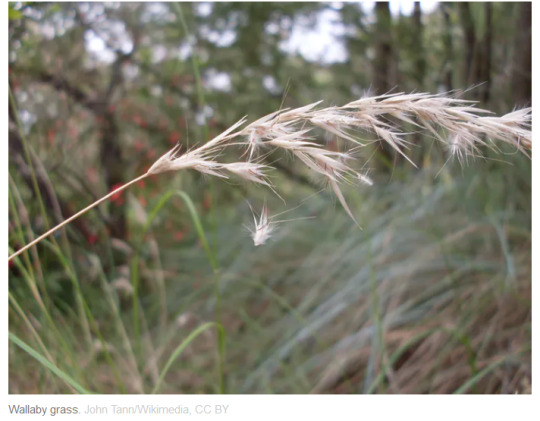
There are around 30 types of wallaby grass in Australia. Native grasslands were once the most extensive habitat of Victoria’s western plains, but are now the most endangered plant community.
Grasslands provide food and habitat for a huge diversity of fauna, particularly birds, such as the peregrine falcon, whistling kite and Australian kestrels. Many animals, such as the legless lizard, little whip snake and fat-tailed dunnart, were once commonplace, but are now scarce in this endangered ecosystem.
Wallaby grass seeds make an excellent bread by pounding them into flour. The leaves and stem are also used to make cultural items, such as nets for fishing and hunting. It’s also incredibly hardy – highly tolerant to frost, heat and drought, and requiring no fertilisers and little water. And it makes an excellent lawn, controlling erosion and weeds.
-------
Headline, images, captions, and text published by: Zena Cumpston (Barkandji). “Food, tools and medicine: 5 native plants that illuminate deep Aboriginal knowledge.” The Conversation. 20 October 2020.
179 notes
·
View notes
Text
if you have a question about aussie slang, for a fic or whatevs, please just ask i don't know all of it, but we do have some fun words and sayings that are day to day statements
esp. the more rural you go
not everyone has the full accent though, because you do get a lot of pressure at work to come across... professional or whatever.
the only one i've never been sure of being an Actual Phrase, or if it Became A Phrase after popularisation on a tv show, is "Stone the Flaming Crows" bc a dude from Neighbours used to say it frequently.
examples of day to day stuff i can think of right now
mad as a frog in a sock (angry about something, went off, off the shits)
mad as a cut snake (usually means 'they're nuts', but can also mean they exploded with anger, usually contextual)
she'll be right (it's fine - can be a flippant statement, can be reassurance, etc)
drongo / galah - (idiot, not very smart, wanker, etc)
dunny = toilet
thunderbox/outhouse / long-drop - usually outdoor toilet
dry as a nun's nasty / dry as a dead dingo's donger (I am thirsty, or It Is Hot AF/we need rain so bad)
chuck a u-ey (do a u-turn)
Oi! (Hey I want your attention/i was surprised, general exclamation, stop that, you are in a lot of fucking trouble mate - depends on the tone of voice and volume) like "OI!" says aunty ruth has just found her dentures in jello and she knows you did it, etc
Bugger off (go away, or sometimes a statement of disbelief)
Yeah nah /Nah yeah (can mean yes, no or maybe depending on what was said directly before the statement)
you cant pull the wool over my eyes - you can't lie to me like that / i can see you are not telling the truth
shut your gob / put a sock in it / put a cork in it - (shut up / shut the FUCK up / close your mouth or i will shut it for you) depends on tone
Ya wally (you idiot)
Roo = kangaroo
o = can be affixed to anything to shorten it
at the servo - gone to the service station, arvo - afternoon, smoko - morning tea, bottlo - where the grog is
goon/goonsack - wine in a box
grog - alcohol
stubbie - beer, ususally
boardies - board shorts
rashie - swimming shirt,
slip, slop, slap - ancient proverb for avoiding sunburn. singing pelican.
thongs - footwear
sheila = female / woman, don't hear this a lot at the moment tbh except in certain contexts or from specific people
'Getting rowdy' = things are heating up, people are riled up, a fight is about to/has just broken out, etc.
DJ's like a mad cunt = one very specific meme about a bad PM we had like 10 years ago. i can't tell you how many PM's ago, it's been game of thrones here lmao
Beyond the black stump / Out whoop-whoop / references to timbuktu (quite a distance away)
strewth!/crickey!/bloody hell - (exclamation of surprise, expletive replacement, etc)
flat out like a lizard drinking (tired / drunk / exhausted / sleeping)
pull a harry holt - (I've heard a dozens variations of this one, it means Go Missing / Disappear, often used as a joke. PM Holt went swimming one day and disappeared)
have a stickybeak (to poke your nose in/investigate/look around)
chuck a wobbly/throw a tanty/chuck a tanty/throw a wobbly (throw a tantrum, i have legit never seen anyone successfully deescalate a situation by telling someone not to chuck a wobbly or throw a tanty, go figure lmao)
bogan - (very specific kind of low-income, generally white, people. sort of like rednecks, but with more stereotypical aussie features like a mullet, singlet tops, sunnies, stubbies, etc. tend to fall under the liberal party ideology - who are our republicans... )
ankle-biters / rugrats / little takkers / gremlins / nippers - (kids, usually the littler ones)
tiff - argument, small fight (had a tiff, had a row)
pav = pavlova
piss/whizz/take a piss = going to pee
vegemite - delicious
Kiwi = New Zealander
Banana benders - the disrespectful bs that apparently other states call anyone living in Queensland, the wankers
station - farming areas that have sheep or livestock usually, have farmhands etc.
dole bludger(s) - (anyone on Centrelink, whether they want to be or not, with no other employment. but like, a lot of people on centrelink have a job that does not cover enough and need additional financial supports to meet a minimum wage, or are students or apprentices, etc. there are people who go on centrelink on and off to avoid engaging in the jobseeking stuff, they are the real dole bludgers, but a lot of richer people tend to call anyone on 'welfare' bludgers)
don't you come the raw prawn with me - (do not lie to me / don't try that shit with me, mate / I wasn't born yesterday /etc)
dak/dack - to dack someone is to come up behind them and yank their pants down (or skirts). Often taking out your boxers, too.)
budgie smugglers - (speedoes, male swimwear)
togs/toggs or cozzie (swimwear, any kind. cozzie = costume)
mozzie - (mosquito)
better than a kick up the backside /better than a kick in the arse - (pretty self explanatory, one of those phrases parents use to get slightly hurt kids to start laughing and/or coworkers to commisserate about new work rules, etc)
I wouldn't piss on (name) if they were on fire - (self-explanatory, you hate them, or they're a useless tit or an insufferable person /a suckup etc, and you would gladly hand them a match)
one for the road = getting a drink for the road, usually. can also make a joke of it like, "one last piss for the road" = I'm going to the bathroom before I leave
here's your handbag, what's your hurry - probs not an aussie phrase but a common joke in my family
----------------
So like, there's some words and items from Australian Indigenous culture that often get used wrong in stereotypical characters, like saying 'gone walkabout', using 'cooee', making digeridoo jokes, and making some really uncomfy 'savages' statements can be very disrespectful. You might want to go looking into Australia's fucked up policies and historical (and only recent) situations before starting any arguments about this stuff... in many ways it mirrors the cruelty of american colonisers to native american peoples, etc.
Avoid some phrases.
Your character gone to cool their head? He's gone off on to soak his head, or he's on his bike (gone away) but he'll be back...
You can use 'Oi, dickhead!'
Please don't mock the names of towns or places, they are often the names from the traditional custodians and inhabitants.
-----------------
Random things:
We drive on the left side of the road, driver's side reversed.
More of our cars are automatic than manual.
Utes aren't atypical, but bigger vehicles are out in rural areas because more than a few of the rural roads are poorly maintained or dirt, with potholes that yoyo your soul into your body.
If you have a character on a long drive on a non-highway, or rural road:
+if you are on a one-lane road and someone is comingthe other way, you both move half-on, half-off; for big vehicles or trucks, you can choose to pull off completely and stop. Just for safety, esp. in rain, fog, mist or late at night.
+at one-lane bridges, you have a give way sign on one side. if you want your characters to have a moment of 'pause to look at each other while driving' or 'a quiet moment of reflection', have them wait for another car or truck to pass from the other side.
These can be a few metres long, to like, a really long bridge.
+They may pass markers that say 'flood level marker' with numbers of 2, 3 or 5 metres. Could be useful to remark on if your fic needs a reason for them to have a crisis.
+Bushfire warning signs (from Low to Catastrophic) are frequent
+Animal Crossing signs are very frequent, and often have a wildlife rescue number on them
+Water restriction signs are in most small towns, they range from levels 1 to 6. This can change what the characters are allowed to do with water in little towns, etc.
+You may occasionally find a small servo and one or two houses.
+pubs don't open/won't serve alcohol until after 10am.
the joke has always been, 'beer on your cornflakes' but you will never be able to actually get that unless you preplanned the night before in your hotel room.
+Around dawn and dusk, a lot of animals like hares, kangaroos, wallabies, sometimes echidnas and koalas and little numbat things, and snakes and bushmice will be close to the road. Sometimes dashing across. They do not react logically to cars approaching, and will leap out at random. Hares do this zigzag nonsense.
If you need the character to hit the brakes frantically, or swerve, this is a good reason. If you are ever driving here and see an animal on the side of the road, flip lights to low beam, slow down and watch to see how they react. If you can. If there's a truck blaring down on you, you may not be able to.
+Emus are in more rural areas. Echidnas sometimes appear on fringes of towns though.
+Kookaburras are a lovely creature, I have rescued a few and they are nice... but their laugh is very grating when it goes off super early in the morning. They eat snakes (good) and baby birds (not so good).
+Lots of snakes round here. LOTS.
Carpet Snakes are pretty common, red-belly black snakes, eastern brown (big danger!!!), whip snakes have declined in my region, keelback snakes, this one black and white banded one we found deceased, etc. Snakes can climb, snakes can SWIM.
Putting something that stinks around a campsite MAY help, but not always.
+Never go swimming in a dam you don't own, and that hasn't been checked, and if no one knows where you are. How deep is it? What's on the bottom? How stirred is the water? etc.
+Kangaroos CAN drown you. They have perfected this attack, and will do it to humans, dogs and other pursuers alike.
They can also eviscerate you with their hind paws or shatter your ribs with a kick. The 'boxing' they do is exceptionally violent.
This seems to surprise people, but like, giraffes can kill each other by slamming their heads into each other, you think a 7 ft swole motherfucking cryptid can't do harm? They can be lovely tho, if they trust you. But DO NOT GO PETTING WILDLIFE.
+Dropbears, austrilanicus vericanthus bitus, are real.
We do make jokes about them, but they are a Problem. The pee on yourself thing won't ward them off, that's more about working out which tourists are the most gullible (and if they run with it, the moistest) lmao. Akubras and other thicker-layered headwear,
+We have wild dogs and feral pigs. Do not fuck with the feral pigs, some are HUGE, and no... they're not just pigs who escaped farms, these are MASSIVE motherfuckers who will Get You if they See You.
Rustling in the night outside the tent? Good Luck.
+Koalas should not be picked up directly. They have claws, and a lot of them have chamydia. I mean if a character saves one in a fic that's fine I guess, but like... someone's getting antibiotics after that lmao.
They are bigger than you think, dumber than you think, and sometimes they have to be chased across a highway with a windscreen cover bc they're not very bright and keep failing to climb metal fences, lmaoooo
+Towns of about 20-30k will have more shops (some franchise, some local owned), servos, fast food places and usually at least two to three shopping centres. Usually small level entertainments like a cinema, or local groups.
+Towns with 10-20k, may have one or two major shopping centres, servos (tracks and RVs catered to), possibly a maccas, and the majority of stores will be local-owned. May have a cinema, but not one that has the newest releases.
Local council may have more festivals, or 'that one thing they're known for'.
+0-10k towns have a small local store, prices usually a bit higher.
A servo, often with capacity for trucks. Local festivals. Characters can cop a bit of side-eye in these places, esp. if they don't fit the traditional ideas or are loud/violently american.
+Grey nomads are a thing. Old people with fancy caravans who drive So Slow, and move all around aus. Several refused to stop during covid and it was like, WHO DO YOU THNK WE'RE TRYING TO KEEP ALIVE BY STOPPING YOU MOVING THROUGH MULTIPLE TOWNS???
+Some rural areas have legit red dirt, its always super cool to look at. Some places have light brown to dark brown, some have more chalky colours or yellowish dirt. Depends.
+Reminder: Australia has very specific gun laws, if your character/s have weapons then they may need to be sneaky or store them specifically in the vehicle. Although if you're talking about like, mad max type rules, then who cares. But if you have them get into a gun fight in a town, the police will come, etc.
Dunno, just ask if you have a question... just trying to think of random things to paint a picture if you have a character over here for a roadtrip or mission or whatever.
11 notes
·
View notes
Photo

PERENTIE
Varanus giganteus
©Laura Quick
The perentie lives in dry, arid parts of Australia, from Western Queensland to coastal Western Australia. It generally prefers rocky hills and outcrops where it can dig a burrow, which may be extensive and have many exits.
This lizard is an efficient predator and will eat nearly anything it can overpower, from other lizards and small mammals to venomous snakes and even small marsupials such as wallabies. Once its prey is caught in its sharp, backwards-pointing teeth, the perentie will violently shake it to death and then swallow it whole.
As the largest monitor lizard in Australia, a perentie typically reaches a nose-to-tail length of six feet or more. Its long claws and strong front legs make it a capable digger and climber, and its powerful bite and whip-like tail help defend it when it feels cornered. This monitor is also an excellent sprinter and can reach speeds of up to 25 miles per hour!

#perentie#varanusgiganteus#australia#monitor lizard#goanna#©laura quick#los angeles zoo and botanical gardens#los angeles zoo#lazoo#glaza#patterned#reptile#fast#lizard#4th largest lizard#nature photography#beautiful patterning
32 notes
·
View notes
Note
reading all the posts through the years of your encounter with various spiders makes me go 😭😭😭😭😭😭😭😭😭😭😭 that's why i'll never ever in my life dream about going to australia it's fucking horrifying i literally would die if a spider ever comes near me i can't even imagine it ughh damn life's hard in australia
lol it’s not that bad pls, just don’t go to queensland, the media over exaggerates it 😭😭look i grew up in malaysia and i lived in a golf course and so it was 10 times worse - my house had not only spiders but also snakes (including venomous ones), monitor lizards, geckos, monkeys, and even a scorpion’s nest, THAT was bad
2 notes
·
View notes